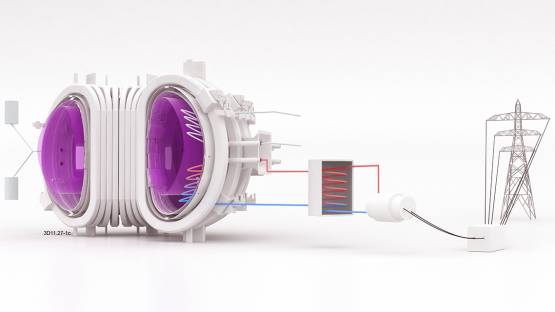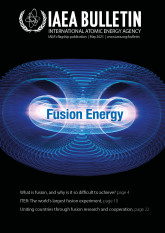
If you would like to learn more about the IAEA’s work, sign up for our weekly updates containing our most important news, multimedia and more.
Demonstration Fusion Plants
A stepping stone to large-scale, commercial electricity production
Irena Chatzis, Matteo Barbarino

Artist’s concept of a fusion power plant converting the heat of fusion into heat and electricity. (Source: EUROfusion)
Demonstration fusion plants
The aim of ITER, the world’s largest fusion experiment, is to prove how to create net energy from a fusion reaction. Demonstrating that net electricity can be produced from fusion will then be the next significant step. This is where demonstration fusion power plants, or DEMOs, will come in.
DEMO-type reactors are more of a design concept than a particular fusion machine configuration. Preliminary designs for publicly funded DEMOs, under development in several countries, are yet to be finalized. This will be done following results of the ITER experiments.
DEMOs are planned to operate almost continuously to produce more than 50 megawatts (MW) of net electrical gain. The key challenge they will set out to address is how to keep the fusion plasma stable for long enough to produce energy on an ongoing basis.
While a lot about DEMOs are still undecided, a public DEMO will likely be a tokamak-type reactor and will use heavy hydrogen isotopes — deuterium and tritium — as fuel. However, the world’s available supply of tritium is limited, and DEMOs themselves will need to produce sufficient tritium supplies through so-called ‘blankets’ that breed and extract tritium. Challenges in the fuelling, exhausting, confining, extracting and separating of tritium will also need to be resolved.
Another major difference between DEMO-type and existing experimental reactors will be the addition of appropriate systems and technologies to capture and convert fusion power into electricity.
“DEMO-type machines require the design and integration of complex components and systems that are not part of existing fusion experimental machines. Components such as tritium breeding blankets, power generation, burn control, and so on, are all required,” said Elizabeth Surrey, Head of Technology at the United Kingdom’s Atomic Energy Authority. “The operating conditions of a DEMO are particularly hostile to materials, as the burning plasma generates a high flux of neutrons and high-power densities on the walls. DEMOs require the development of new materials and technologies.”
“ DEMOs require the development of new materials and technologies.
The role of the IAEA
Groups of researchers in various countries are exploring DEMO concepts and approaches. The IAEA facilitates international coordination and the sharing of best practices through a series of Technical Meetings, and, since 2012, through its regular DEMO Programme Workshops. These platforms foster discussion on physics and technology issues, facilitate the sharing of strategies for DEMO programmes and analyse potential courses of action. Over time, the topical emphasis has shifted from broad visions to the detailed technical challenges that must be overcome.
“By concentrating on identifying problems and discussing ongoing research and development, rather than results, the IAEA Technical Meeting series and DEMO Programme Workshops enable the community to define requirements and analyse possible solutions in a collaborative manner. One example is the emergence of plasma control as a major issue for DEMO-type machines when long, or near continuous plasma operation is required,” said Surrey, who served as chair for the last three DEMO Programme Workshops, between 2016 and 2019.
Plans around the world
While various paths are still being explored to reach fusion-based electricity, the science and technology issues to be resolved are broadly agreed. Individual countries have different timelines, but the general consensus among scientists is that they can have an electricity-producing DEMO-type reactor built and operating by 2050.
In China, significant progress has been made in planning for the China Fusion Engineering Test Reactor (CFETR). This device will help bridge the gap between ITER and DEMOs. Construction of the CFETR will start in the 2020s and will be followed by construction of a DEMO in the 2030s.
In Europe, EUROfusion is responsible for developing the design of a DEMO. The project is currently in its conceptual design phase (2021–2027) and aims to demonstrate the technological and economic viability of fusion by producing several hundred MWs of net electricity.
India has announced plans to begin building a device called SST-2 to qualify reactor concepts and components for a DEMO around 2027 and will then start construction of a DEMO in 2037.
The Japanese Joint Special Design Team for Fusion DEMO is currently working on the conceptual study of a steady state DEMO (JA DEMO), with construction planned to start around 2035.
In 2012, the Republic of Korea initiated a conceptual design study for ‘K-DEMO’, targeting construction by 2037, with the potential for electricity generation starting in 2050. In its first phase (2037–2050), K-DEMO will be used to develop and test components, and will then utilize these components. In its second phase, after 2050, it is hoped that it will demonstrate net electricity generation.
The Russian Federation is planning a fusion–fission hybrid facility called DEMO Fusion Neutron Source (DEMO-FNS), which will harvest fusion-produced neutrons to turn uranium into nuclear fuel and destroy radioactive waste. The DEMO-FNS is planned to be built by 2023 and is part of the country’s fast-track strategy to establishing a fusion power plant by 2050.
Fusion experts in the United States of America recently issued two reports that recommend starting a national research and technology programme, including public–private partnerships, to ultimately bring fusion to commercial viability. It aims to do this in the period 2035–2040, with the aim of positioning the country as a leader in fusion and speeding up its transition to low carbon energy by 2050.
In parallel, numerous privately funded commercial enterprises are also making strides in developing concepts for fusion power plants, drawing on the know-how generated over years of publicly funded research and development and proposing even more aggressive timelines.






